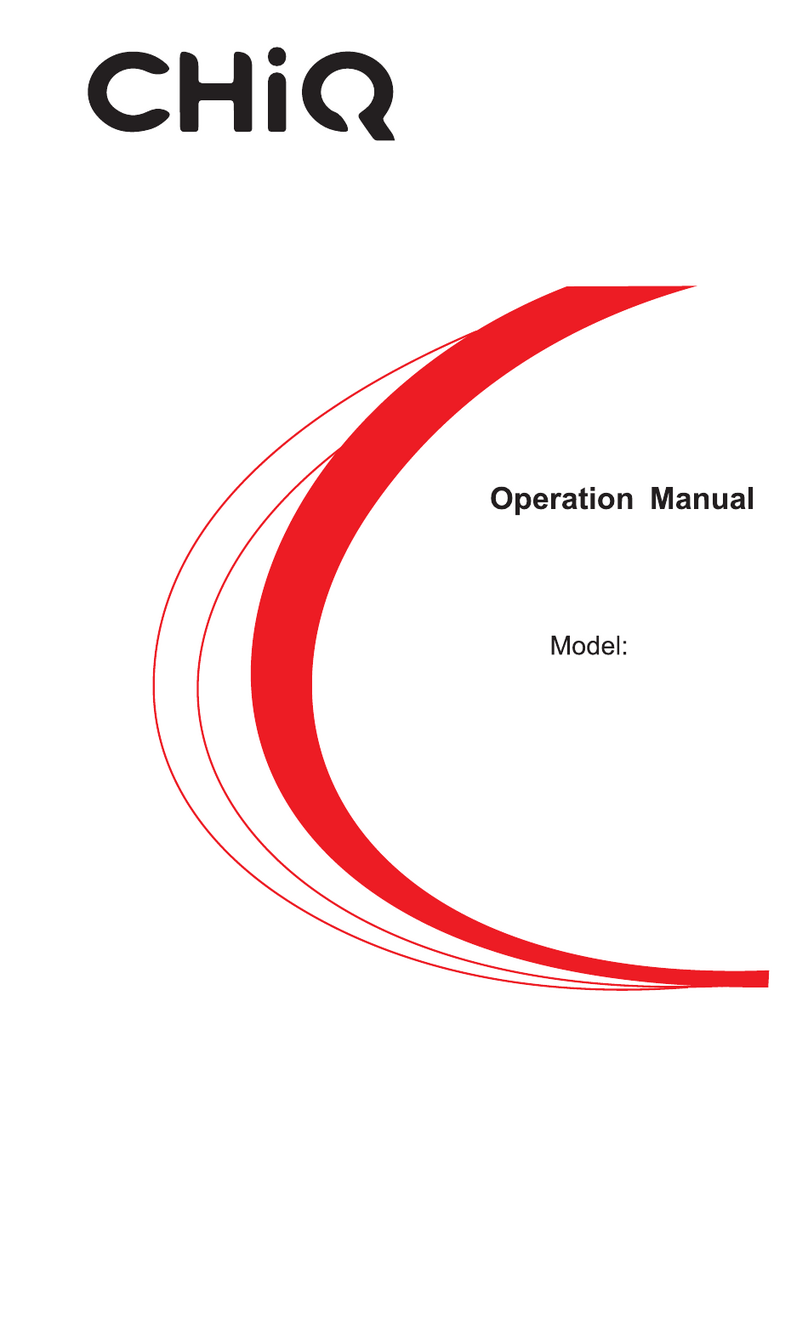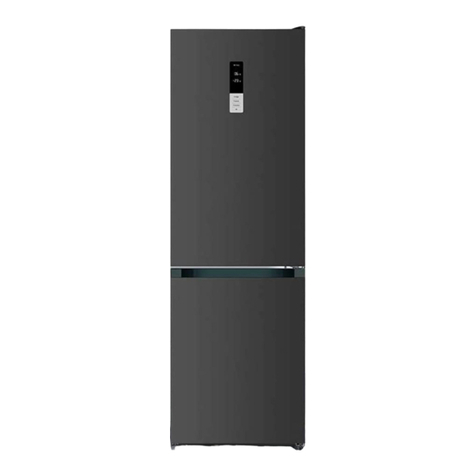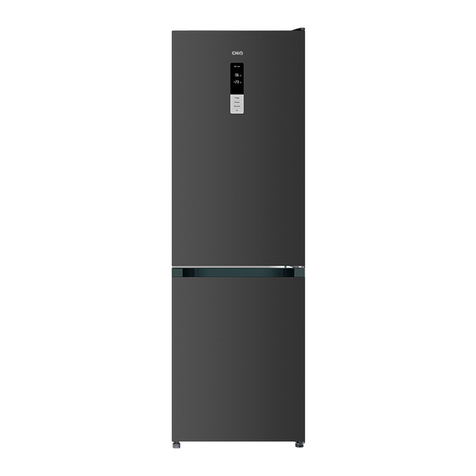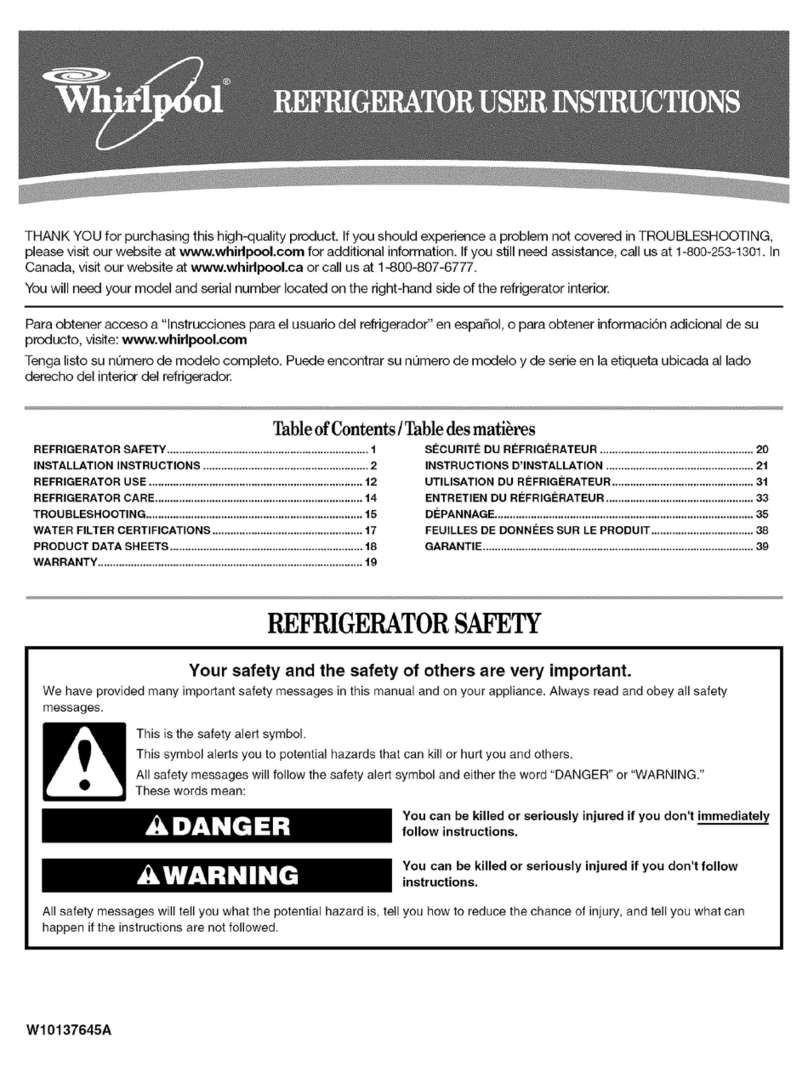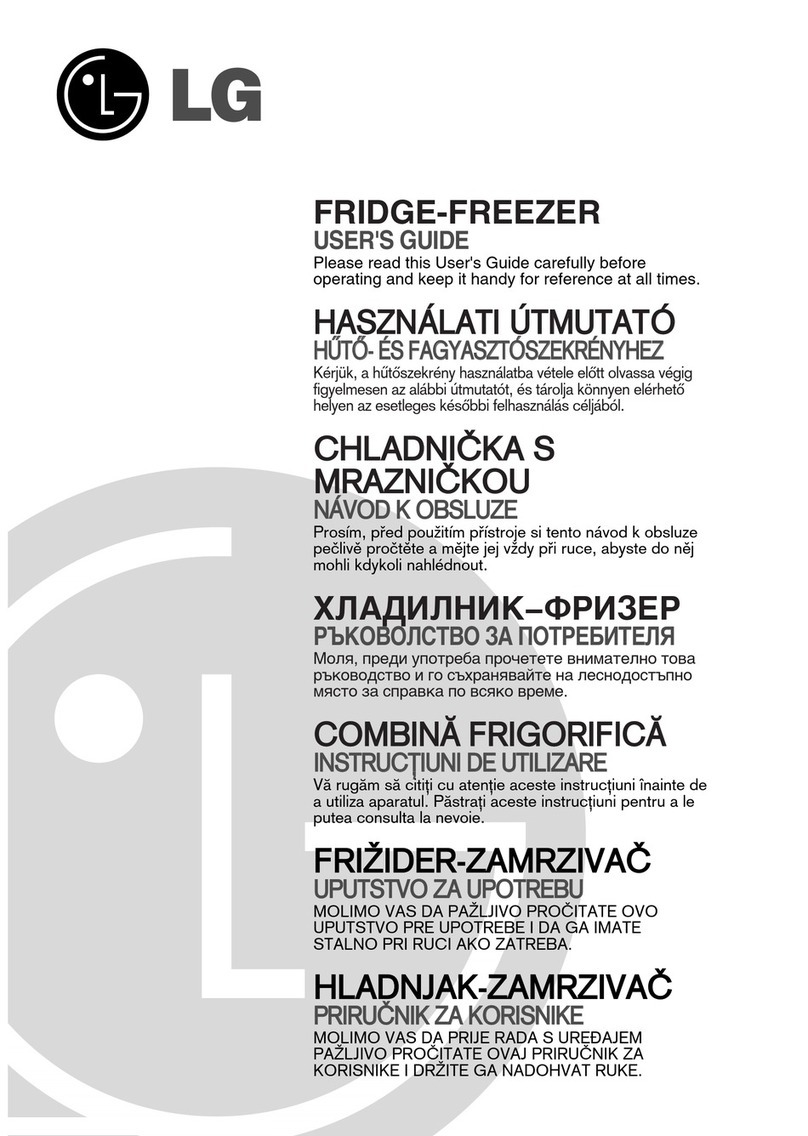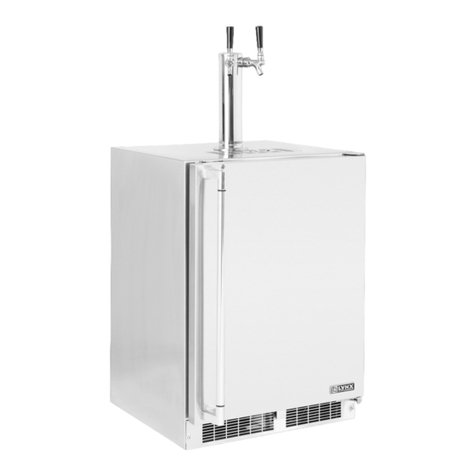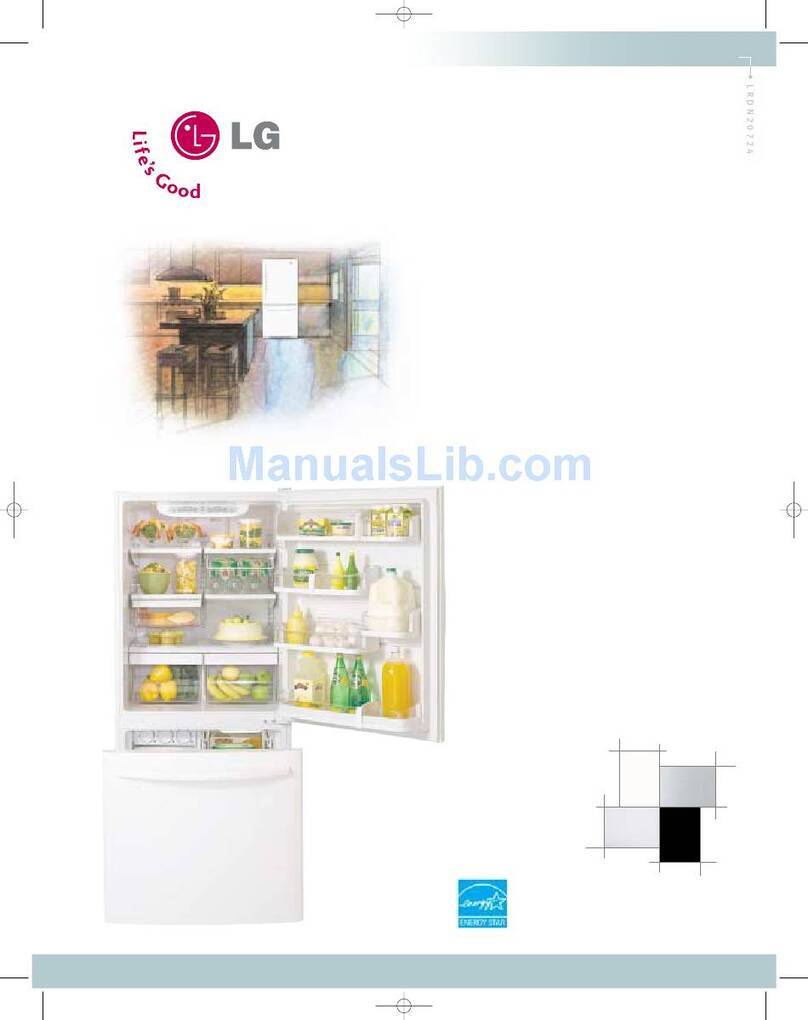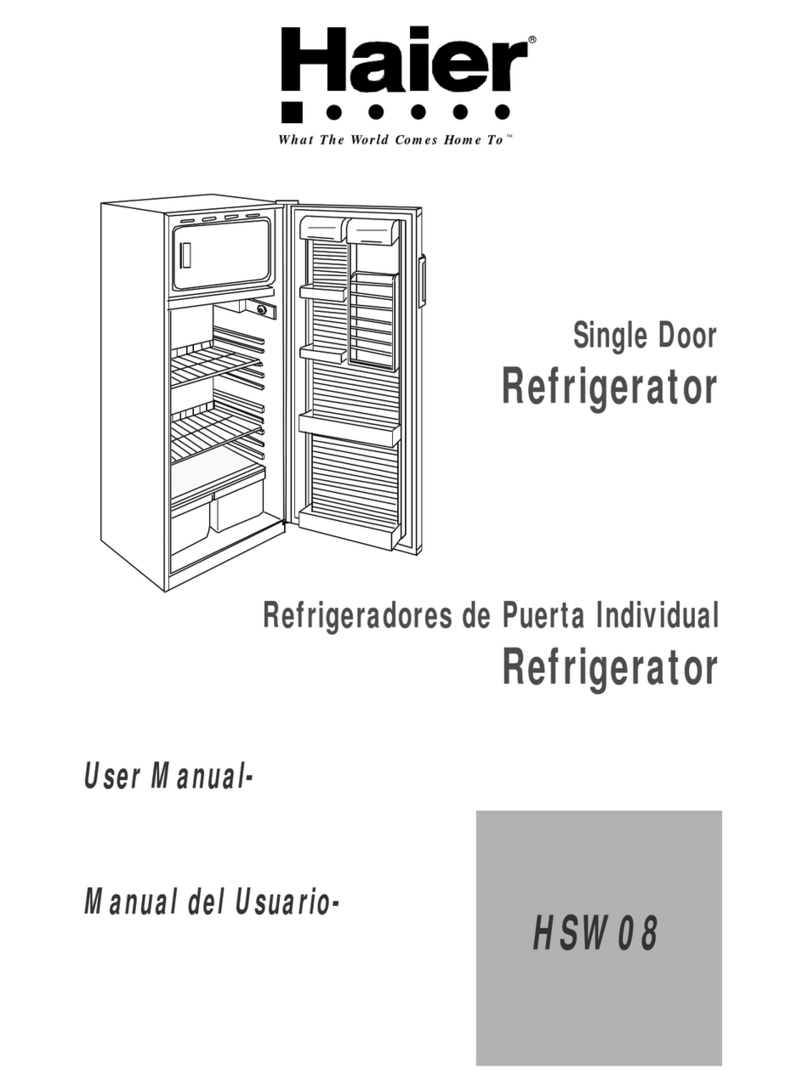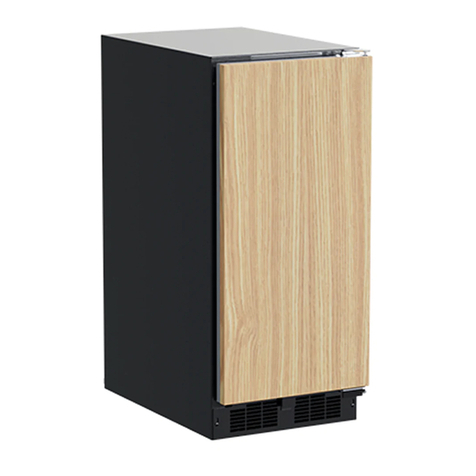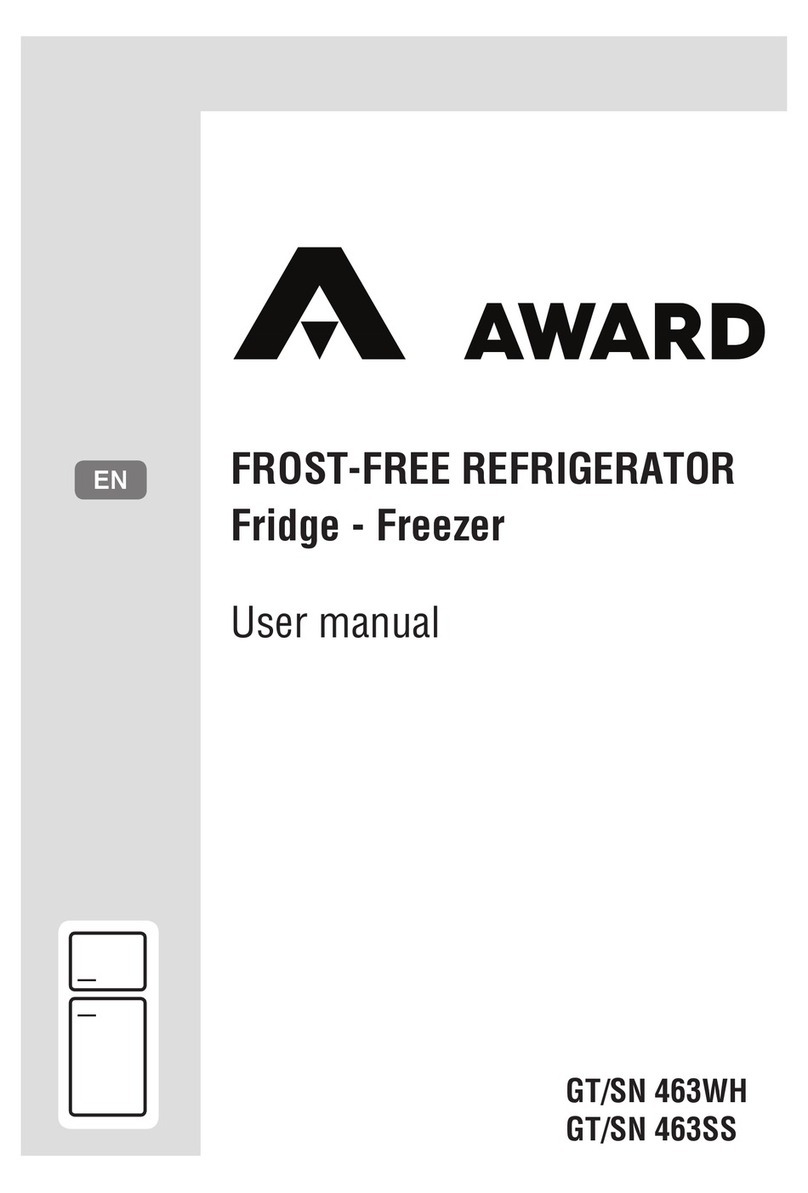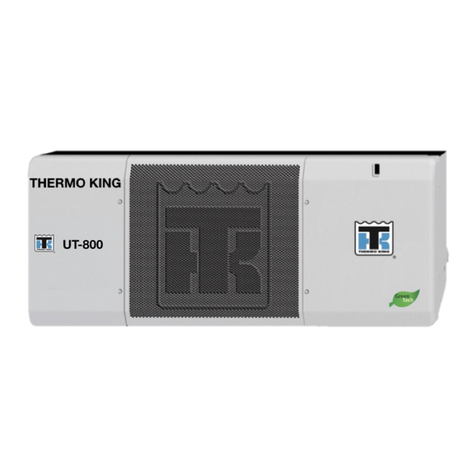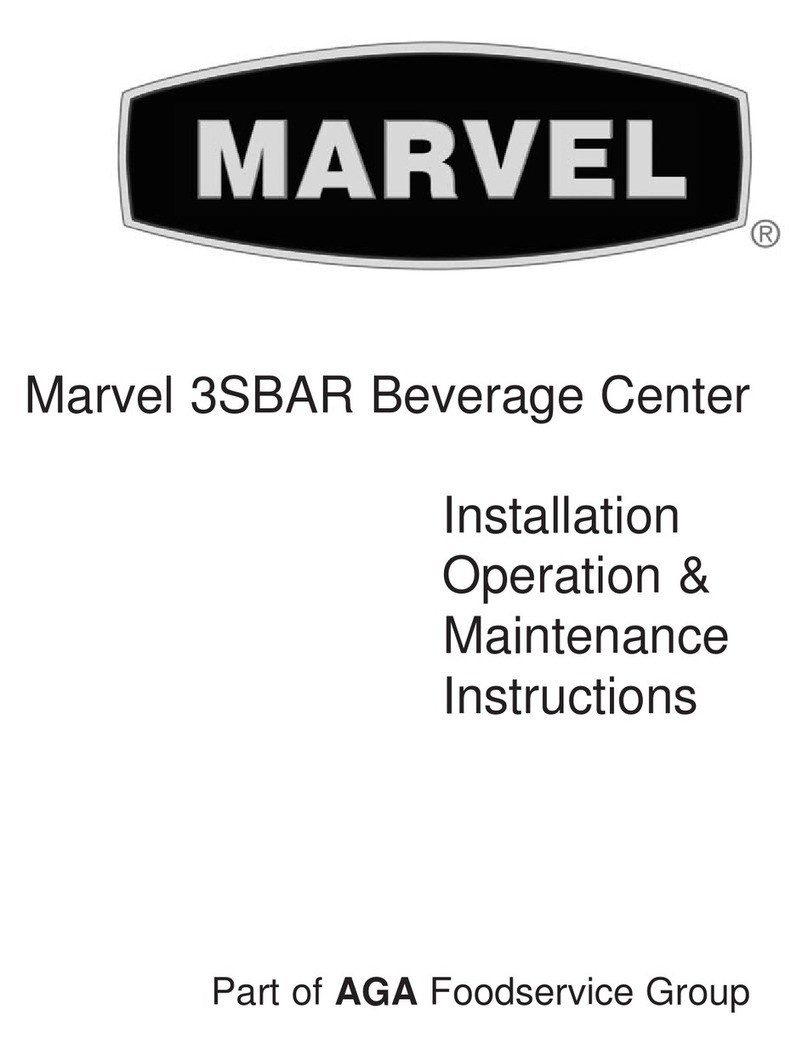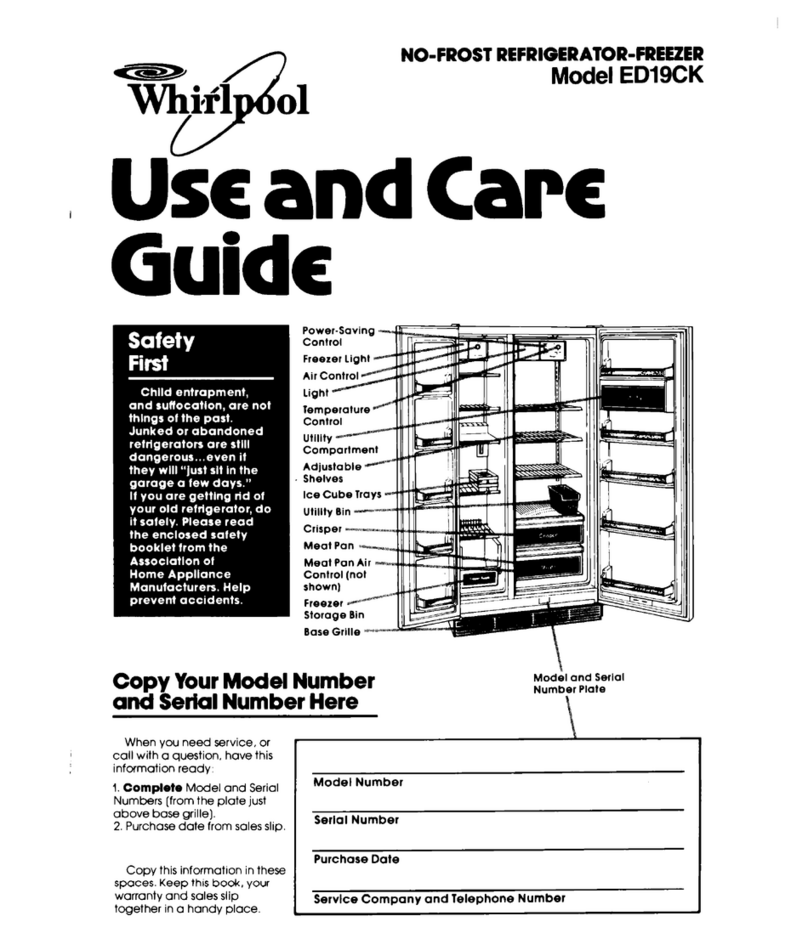ChiQ CQRT07Z1GD1 User manual

IMPORTANT SAFETY INSTRUCTIONS
WARNING
1.Read these instructions.
2. Keep these instructions.
3.Heed all warnings.
4.Follow all instructions.
5. Do not use your refrigerator near water.
6.Clean only with a damp cloth.
7.Do not block any ventilation openings. Install in accordance with the manufacturer’s instructions.
8. Do not install near any heat sources, such as radiators, heat registers, stoves, or other apparatus (including amplifiers)
that produce heat.
9.Do not defeat the safety purpose of the polarized or grounding-type plug. A polarized plug has two blades with one
wider than the other. A grounding type plug has two blades and a third grounding prong. The wide blade or the third
prong is provided for your safety. If the provided plug does not fit into your outlet, consult an electrician for
replacement of the obsolete outlet.
10. Protect the power cord from being walked on or pinched, particularly at plugs, convenience receptacles, and the point
where it exits from your refrigerator.
11. Do not attempt to modify or extend the power cord of your refrigerator.
12. Unplug your refrigerator during lightning storms or when it will not be used for long periods of time.
13. Make sure that the available AC power matches the voltage requirements of your refrigerator.
14. Do not handle the plug with wet hands. This could result in an electric shock.
15. Unplug the power cord by holding the plug, never by pulling the cord.
16. Turn off your refrigerator before unplugging it.
17.Refer all servicing to qualified service personnel. Servicing is required when your refrigerator has been damaged in
any way, such as the power-supply cord or plug is damaged, liquid has been spilled or objects have fallen into your
refrigerator, your refrigerator has been exposed to rain or moisture, does not operate normally, or has been dropped.
18. To reduce the risk of fire or electric shock, do not expose your refrigerator to rain, moisture, dripping, or splashing, and
no objects filled with liquids should be placed on top of it.
19 Do not use extension cords or ungrounded (two prong) adapters. If the power cord is too short, have a qualified
electrician install an outlet near your refrigerator. Use of an extension cord can negatively affect your refrigerator’s
performance.
20Your refrigerator is not intended for use by persons (including children) with reduced physical, sensory, or mental
capabilities, or lack of experience and knowledge, unless they have been given supervision or instruction concerning
use of your refrigerator by a person responsible for their safety.
21 Children should be supervised to ensure that they do not play with your refrigerator.
22If the power cord is damaged, it must be replaced by the manufacturer, its service agent, or similarly qualified person,
inorder to avoid a hazard.
WARNING
Electric Shock Hazard

1
Failure to follow these instructions can result in electric shock, fire, or death.
1.WARNING–Keep ventilation openings, in both your refrigerator and the built-in structure, clear of obstruction.
2.WARNING–Do not touch the interior of your refrigerator with wet hands. This could result in
frostbite.
3.WARNING–Do not use mechanical devices or other means to accelerate the defrosting process, other than those
recommended by the manufacturer.
4.WARNING–Do not damage the refrigerant circuit.
5.WARNING–Do not damage the refrigerant tubing when handling, moving, or using your refrigerator.
6.WARNING–DANGER—Never allow children to play with, operate, or crawl inside your refrigerator.
Risk of child entrapment. Before you throw away your old refrigerator:
•Take off the door.
•Leave the shelves in place so that children may not easily climb inside.
7. WARNING—Do not use electrical appliances inside the food storage compartments of the appliance unless they are of
the type recommended by the manufacturer.
8.Unplug your refrigerator before carrying out user maintenance on it.
9.If power cord is damaged, it must be replaced by the manufacturer, its service agent, or similar qualified persons in order
to avoid a hazard.
10.Follow local regulations regarding disposal of your refrigerator due to flammable refrigerant and gas. All refrigeration
products contain refrigerants, which under the guidelines of federal law must be removed before disposal. It is the
consumer's responsibility to comply with federal and local regulations when disposing of this product.
11. Do not store explosive substances such as aerosol cans with a flammable propellant in this appliance.
12. The appliance is not intended for use by persons (including children) with reduced physical, sensory, or mental
capabilities, or lack of experience and knowledge, unless they have been given supervision or instruction concerning
use of your refrigerator by a person responsible for their safety.
Children should be supervised to ensure that they do not play with your refrigerator.
13 .This appliance is intended to be used in household and similar applications such as
– staff kitchen areas in shops, offices and other working environments.
– farm houses and by clients in hotels, motels and other residential type environments.
– bed and breakfast type environments.
– catering and similar non-retail applications.
Grounding requirement
Your refrigerator must be grounded. Your refrigerator is equipped with a cord having a grounding wire with a grounding
plug. The plug must be inserted into an outlet that is correctly installed and grounded.
Incorrect use of the grounding plug can result in a risk of electric shock. Consult a qualified electrician or service person if
the grounding instructions are not completely understood, or if doubt exists as to whether your refrigerator is
correctlygrounded.
Locks
If your Fridge/Freezer is fitted with a lock, to prevent children being entrapped keep the key out of reach and not in the
vicinity of the appliance. If disposing of an old Fridge/Freezer break off any old locks or latches as a safeguard.
INTRODUCTION
INSTALLATION
Location
When selecting a position for your Fridge/Freezer you should make sure the floor is flat and firm, and the room is well
ventilated. Avoid locating your Fridge/Freezer near a heat source, eg, cooker, boiler or radiator. Also avoid direct sunlight
in out-buildings or sun lounges. If you are placing your Fridge/Freezer in an out-building such as a garage or annex
ensure that the Fridge/Freezer is placed above the damp course, otherwise condensation will occur on the Fridge/Freezer
cabinet. When working, the refrigerator gives off heat to surroundings. Therefore, at least 300mm of free space should be
No Description
1 Freezer Shelf
2 Thermostat
3 Refrigerator Shelf
4 Salad Crisper Cover
5 Salad Crisper
6 Adjustable Foot
7 Egg Tray
8 Bottle Rack

2
spared at the top side, more than 100mm on both sides, and above 50mm at the back side of the refrigerator.
Leveling the Fridge/Freezer
If the Fridge/Freezer is not level, the door and magnetic seal alignment will be affected and may cause
you Fridge/Freezer to work incorrectly. Once the Fridge/Freezer is placed in its final location, adjust the
leveling feet at the front by turning them.
Cleaning before use
Wipe the inside of the Fridge/Freezer with a weak solution of bicarbonate of soda. Then rinse with
warm water using a damp sponge or cloth. Wash the baskets and shelves in warm soapy water and dry
completely before replacing in the Fridge/Freezer. The external parts of the Fridge/Freezer can be
cleaned with wax polish.
Before plugging in YOU MUST
Check that you have a socket which is compatible with the plug supplied with the Fridge/Freezer.
Before switching on!
DO NOT SWITCH ON UNTIL FOUR HOURS AFTER MOVING THE FRIDGE/FREEZER.
The coolant fluid needs time to settle. If the appliance is switched off at any time, wait 30 minutes before switching back on
to allow the coolant fluid to settle.
Before filling your Fridge/Freezer
Before storing foods in your Fridge/Freezer, turn the Fridge/Freezer on and wait for 24 hours, to make sure it is working
properly and to allow the Fridge/Freezer to fail to the correct temperature.
START
Testing
1. Clean the parts of the refrigerator with lukewarm water containing a little neutral detergent and with clear water, and
wipe them dry.
Notes: Electric parts of the refrigerator can only be wiped by dry cloth.
2.Turn the thermostat knob to the "4" position, turn on electricity. The compressor and the light inside the refrigerator begin
to work.
3.Close the door 30 minutes later, if the temperature in the freezer compartment decreased obviously, it shows that the
refrigerator system works well. When the refrigerator operates for a period of time, the temperature controller will
automatically set the temperature within limits it opens.
4.If the above steps are successful, the trial operations finish. The refrigerator works normally.
Adjusting the temperature
The temperature of the appliance can be adjusted by turning the thermostat dial.
•The thermostat can be set between 1 and 7.
•1 is the warmest setting.
•7 is the coldest setting.
•The recommended setting is 4.
•Set the dial to 0 to turn off the cooling function.
Internal temperature of the appliance can vary based on ambient temperature, the quantity of items
stored and how frequently the door is opened.
Fast Freeze
1. Fast freezing makes water in the food form into fine ice crystal, so as to prevent the cell membrane from being
damaged and the cytoplasm from being lost when thawing, thus preserving the original freshness and nutrition of food.
2. Fresh food and fish to be preserved for a long time should be frozen in a fast manner. To realize fast freezing, please
adjust the knob switch to mode "7" before adding the food.
3. After fast freezing, turn the knob back to its original mode (In general, the fast freezing time shall not exceed 4 hours).
IN USE
1. The appliance might not operate consistently (possibility of defrosting of contents or temperature becoming too warm in
the frozen food compartment) when sited for an extended period of time below the cold end of the range of temperatures
for which the refrigerating appliance is designed
2. The fact that the internal temperatures could be affected by such factors as the location of the refrigerating appliance,
ambient temperature and the frequency of door opening, and, if appropriate, a warning that the setting of any temperature
control device might have to be varied to allow for these factors
3. The fact that effervescent drinks should not be stored in food freezer compartments or cabinets or in low-temperature
compartments or cabinets, and that some products such as water ices should not be consumed too cold
4.The need to not exceed the storage time(s) recommended by the food manufacturers for any kind of food
5. The fact that a rise in temperature of the frozen food during manual defrosting, maintenance or cleaning could shorten
the storage life
6. It is better wrapping the frozen food in several layers of the glass shelves.
7. the care required with regard to frozen food in storage in the event of an extended non-running of the refrigerating
appliance (interruption of power supply or failure of the refrigerating system)
Tips for keeping food perfect in the Fridge
Take extra care with meat and fish
Cooked meats should always be stored on a shelf above raw meats to avoid bacterial transfer. Keep raw meats on a plate
which is large enough to collect juices and cover it with cling film or foil.
Leave space around food
This allows cold air to circulate around the Fridge, ensuring all parts of the Fridge are kept cool.
Wrap up food!
To prevent transfer of flavors and drying out, food should be separately packed or covered. Fruit and vegetables need not

3
be wrapped.
Pre-cooked food should be cooled properly
Allow pre-cooked food to cool down before placing in the Fridge. This will help to stop the internal temperature of the
Fridge from rising.
Shut the door!
To prevent cold air escaping, try to limit the number of times you open the door. When retuning from shopping, sort foods
to be kept in your Fridge before opening the door. Only open the door to put food in or take it out.
Where to store your foods in the fridge
Cool area
This is where to store foods which will keep longer if they are kept cool. Milk, eggs, yogurt, fruit juices, hard cheeses eg.
Cheddar. Opened jars and bottles of salad dressings, sauces and jams. Fats, eg. Butter, margarine, low-fat speads,
cooking fats and lard.
Coldest area
This is where foods which must be cold to keep them safe should be kept:
·Raw and uncooked foods should always be wrapped.
·Pre-cooked chilled foods, eg. Ready meals, meat pies, soft cheeses.
·Pre-cooked meats eg. Ham,
·Prepared salads(including pre-packed mixed green salads, rice, potato salad etc).
·Desserts, eg. Fromage frais, home-prepared food and leftovers or cream cakes.
NOTE:Always wrap and store raw meat, poultry and fish on the lowest shelf at the bottom of
the fridge. This will stop them dripping onto, or touching other foods. Do not store inflammable gasses or liquids in the
fridge.
Tips for shopping for frozen foods
Your Freezer is 4 star
When you are buying frozen food, look at the Storage Guidelines on the packaging. You will be able to store each item of
frozen food for the period shown against the 4 star rating. This is usually the period stated as “Best, Before”, found on the
front of the packaging.
Choose packs carefully
Make sure the frozen food package is in perfect condition.
Purchase frozen food last
Always buy frozen products last on your shopping trip or visit to the supermarket.
Keep frozen foods together
Try to keep frozen food together whilst shopping, and on the journey home as this will help to keep the food cooler.
Store food straight away
Don’t buy frozen food unless you can freeze it straight away. Special insulated bags can be bought from most
supermarkets and hardware shops. These keep frozen food cold for longer.
Thawing frozen food
For some foods, thawing before cooking is unnecessary. Vegetables and pasta can be added directly to boiling water or
steam cooked. Frozen sauces and soups can be put into a saucepan and heated gently until thawed.
Freezing fresh foods, useful tips
Use quality food and handle it as little as possible. Freeze food in small quantities, it freezes faster, takes less time to thaw
and enables you to eat it in the quantity you need.
Preparations for freezing
·Leave cooked food to cool completely.
·Chill food in a Fridge before freezing if possible.
·Consider how you want to cook the food before freezing it.
·Don’t freeze food in metal containers as you may want to microwave it straight from the Freezer.
·Use special Freezer bags available from supermarkets, Freezer film, polythene bags, plastic containers, aluminum foil for
acidic foods(such as citrus fruits).
Do not use thin cling film or glass. Do not use used food containers (unless cleaned thoroughly first).
·Exclude as much air from the container as possible. You could buy a special vacuum pump which sucks excessive air out
of the packaging.
·Leave a small amount of “air space” when freezing liquids, to allow for expansion.
·You can use the space in the Freezer most efficiently if you freeze liquids(or solids with liquids, such as stew) in square
blocks.
This is known as “performing” Pour the liquid into a polythene bag which is inside a square sided container. Freeze it like
this, then remove it from the container and seal the bag.
Recommended storage periods
For recommended food storage time, refer to the information given on your food packaging.
Defrosting
After a period of use, a thin layer of frost will be formed on the freezer compartment inner wall (or evaporator) surface,
which may affect the refrigeration effect if exceeding 5mm in thickness. In such case, you need to gently scrape the frost
off using an ice scraper rather than the metal or sharp hardware. Frosts need to be cleared off every 3 months or so, and if
the normal use of drawers and normal access of foods are affected by frosting, make sure to remove the frosts in a timely
manner. Follow the following steps to remove frosts:
1. Take out the frozen foods, shut off the mains power supply, open the refrigerator door, and gently remove the frosts
from the inner wall with an ice scraper. To speed up the thawing process, you are suggested to place a bowl of hot water
inside the refrigerator/freezer, and when the solid ice frosts become loose, use an ice scraper to scrape them off and then

4
take them out.
2. After defrosting, clean the refrigerator/freezer inside, and switch on the power supply.
Cleaning inside the Fridge/Freezer
After defrosting you should clean the Fridge/Freezer internally with a weak solution of bicarbonate of soda. Then rinse
with warm water using a damp sponge or cloth and wipe dry. Wash the baskets in warm soapy water and ensure they are
completely dry before replacing in the Fridge/Freezer. Condensation will form on the back wall of the Fridge; however it
will normally run down the back wall and into the drain hole behind the salad bin.
The drain hole will have a “cleaning spike” inserted into it. This ensures that small pieces off food can not enter the drain.
After you have cleaned the inside of your Fridge and removed any food residues from around the whole, use the “cleaning
spike” to make sure that there are no blockages.
Cleaning outside the Fridge/Freezer
Use standard non-abrasive detergent diluted in warm water to clean the Fridge/Freezer exterior.
The grille of the condenser at the back of the Fridge/Freezer and the adjacent components can be vacuumed using a soft
brush attachment.
Do not use harsh cleaners, scouring pads or solvents to clean any part of the Fridge/Freezer
TROUBLESHOOTING AND MAINTENANCE
Trouble Shooting
Power cut
If the internal temperature of the Fridge/Freezer compartment is -18℃or less when the power returns, your food is safe.
The food in your Fridge/Freezer will remain frozen for approx 16 hours with the door closed. Do not open the
Fridge/Freezer door more than necessary.
The Fridge/Freezer is exceptionally cold
You may have accidentally adjusted the thermostat control dial to a higher position.
The Fridge/Freezer is exceptionally warm
The compressor may not be working. Turn the thermostat control dial to the maximum setting and wait a few minutes. If
there is no humming noise, it is not working. Contact the local store where your purchase was made.
The Fridge/Freezer is not working
Check it is plugged in and switched on. Check that the fuse in the plug has not blown. Plug
In another appliance, such as a lamp, to see if the socket is working. The Fridge/Freezer should be placed in a well
ventilated room. Leave the Fridge/Freezer for 30 minutes.
Condensation appears on the outside of the Fridge/Freezer
This may be due to a change in the room temperature. Wipe off any residue of moisture. If the problem continues contact
the local store where your purchase was made.
GURGLING, WHOOSHING
These noises are caused by the circulation of the refrigerant liquid in the cooling system. It has become more pronounced
since the introduction of CFC free gases. This is not a fault and will not affect the performance of your Fridge/Freezer.
HUMMING, PURRING OR PULSATING
This is the compressor motor working, as it pumps the refrigerant around the system.
Moving the Fridge/Freezer
Location
Do not place your Fridge/Freezer near a heat source, eg. Cooker, boiler or radiator. Also avoid direct sunlight in
out-buildings or sun lounges.
Leveling the Fridge/Freezer
Make sure the Fridge/Freezer is level. Use the rotating leveling feet at the front. If the Fridge/Freezer is not level, the
doors and magnetic seal alignments will be affected and may cause your Fridge/Freezer to work incorrectly.
Do not turn on the Fridge/Freezer for 4 hours
After the Fridge/Freezer is in place it needs to be left for 4 hours. This allows time for the coolant to settle.
Installation
Don’t cover or block the vents or grilles of your appliance.
NOTE: When the environment is high temperature and high humidity, if opening the refrigerator door too often,
there will be some frost at the back of fridge part(inside of refrigerator) and the water in water tray(located on top
of compressor) will overflow, This is not breakdowns. Please power off and clear the frost and water in time.
Vacation Time
•Turn off the refrigerator first and then unplug the unit from the wall outlet.
•Remove all the food.
•Clean the refrigerator.
•Leave the lid open slightly to avoid possible formation of condensation, mold, or odors.
•Use extreme caution in the case of children. The unit should not be accessible to child’s play.
•Short vacations: Leave the refrigerator operating during vacations of less than three weeks.
•Long vacations: If the appliance will not be used for several months, remove all food and unplug the power cord.
Clean and dry the interior thoroughly. To prevent odor and mold growth, leave the door open slightly: blocking it
open if necessary or have the door removed.
How to save energy
01. Install the refrigerator in the coolest part of the room, out of direct sunlight and away from heating ducts or registers.
Do not place the refrigerator next to heat-producing appliances such as a range, oven or dishwasher.
02. The refrigerator door should remain open only as long as necessary; do not place hot food inside the refrigerator.
03. Organize the refrigerator to reduce door openings .Remove as many items as needed at one time and close the
door as soon as possible.
04. The refrigerator door should be properly closed to avoid increased energy consumption, and the formation of excess

5
ice and / or condensation inside.
05. Constantly circulating cold air keeps the temperature homogenous inside the refrigerator. For this reason, it is
important to properly distribute the food, to facilitate the flow of air.
06. Cover foods and wipe containers dry before placing them in the refrigerator. This cuts down on moisture build-up
inside the unit.
07. Do not overcrowd the refrigerator or block cold airvents. Doing so causes the refrigerator to run longer and use more
energy. Shelves should not be lined with aluminum foil, wax paper or paper toweling. Liners interfere with cold air
circulation, making the refrigerator less efficient, which could cause food spoilage.
08. During prolonged absences (example: vacations), it is advisable to disconnect the refrigerator, remove all the food,
and clean it . The door should be left slightly open to avoid mold and unpleasant odors. This will not affect the
refrigerator when it is reconnected.
09. During short absences (example: holidays), the refrigerator can remain on. However, remember that prolonged
power outages may occur while you are gone.
Servicing
This product should be serviced by an authorized engineer and only genuine spare parts should be used.
Under no circumstances should you attempt to repair the appliance yourself.
Repairs carried out by inexperienced persons may cause injury or serious malfunctioning. Contact the local store where
your purchase was made.
When the appliance is not in use for long periods, disconnect from the electricity supply, empty all foods and clean the
appliance, leaving the door ajar to prevent unpleasant smells.
Lamps can only be replaced by the manufacturer , together with a part of the appliance.
Changing the internal light
1. Before carrying out the bulb replacement always press and turn the thermostat control to dial to position “OFF”, then
disconnecting the mains supply.
2. Hold and lift up the light bulb cover.
3. Remove the old bulb by unscrewing it in an anti-clockwise direction.
4. Replace with a new bulb (10W) by screwing it in a clockwise direction marking sure that it is secure in the bulb
holder.
Refit the light cover and re-connect your Fridge/Freezer to the mains supply and switch on.
THIS APPLIANCE MUST BE EARTHED.
This appliance is fitted with a plug which will be suitable for use in all houses fitted with sockets to current specifications.
If the fitted plug is not suitable for your socket outlets, it should be cut off and carefully disposed of. To avoid a possible
shock hazard, do not insert the discarded plug into a socket.
This appliance complies with the EEC Directives.
Table of contents
Other ChiQ Refrigerator manuals

ChiQ
ChiQ CQFU13Y1GD1W User manual
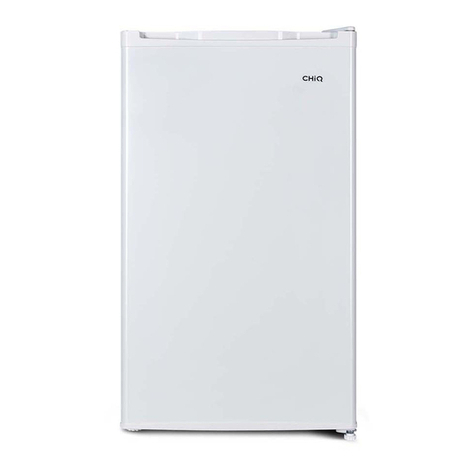
ChiQ
ChiQ CSR090DW User manual

ChiQ
ChiQ CQRD02Z1GD1 User manual

ChiQ
ChiQ CBM117L42 User manual
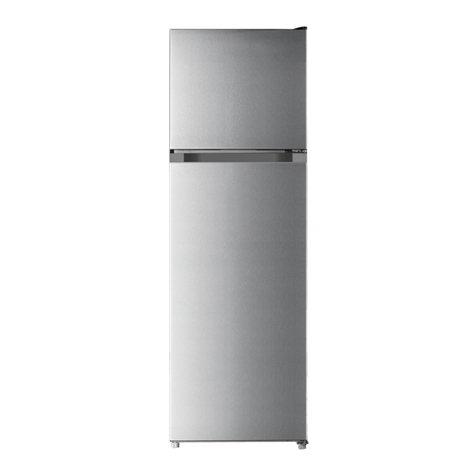
ChiQ
ChiQ CQRT09Y1GD1W User manual
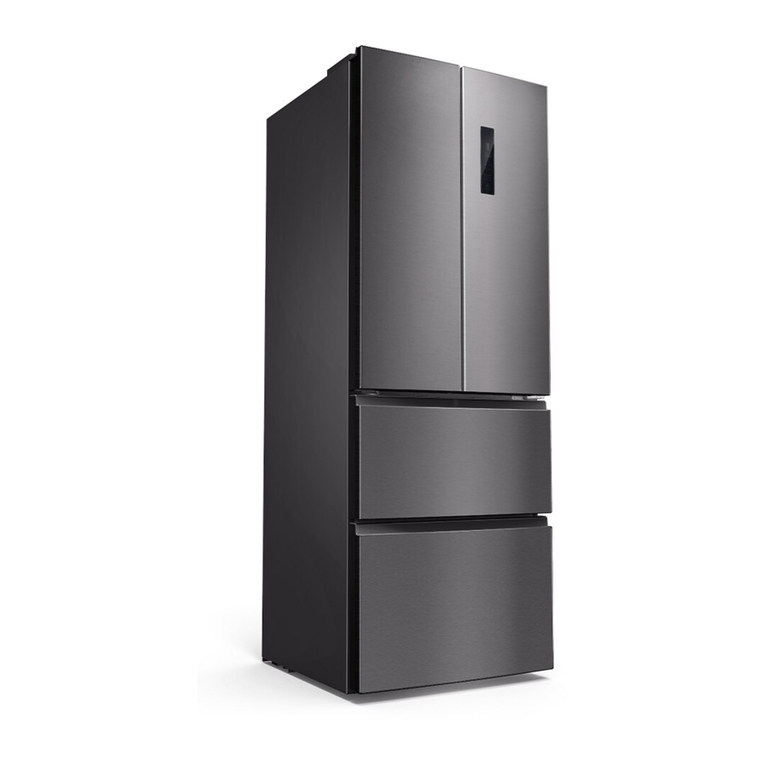
ChiQ
ChiQ CFD337NEI42 User manual

ChiQ
ChiQ CSH431W User manual
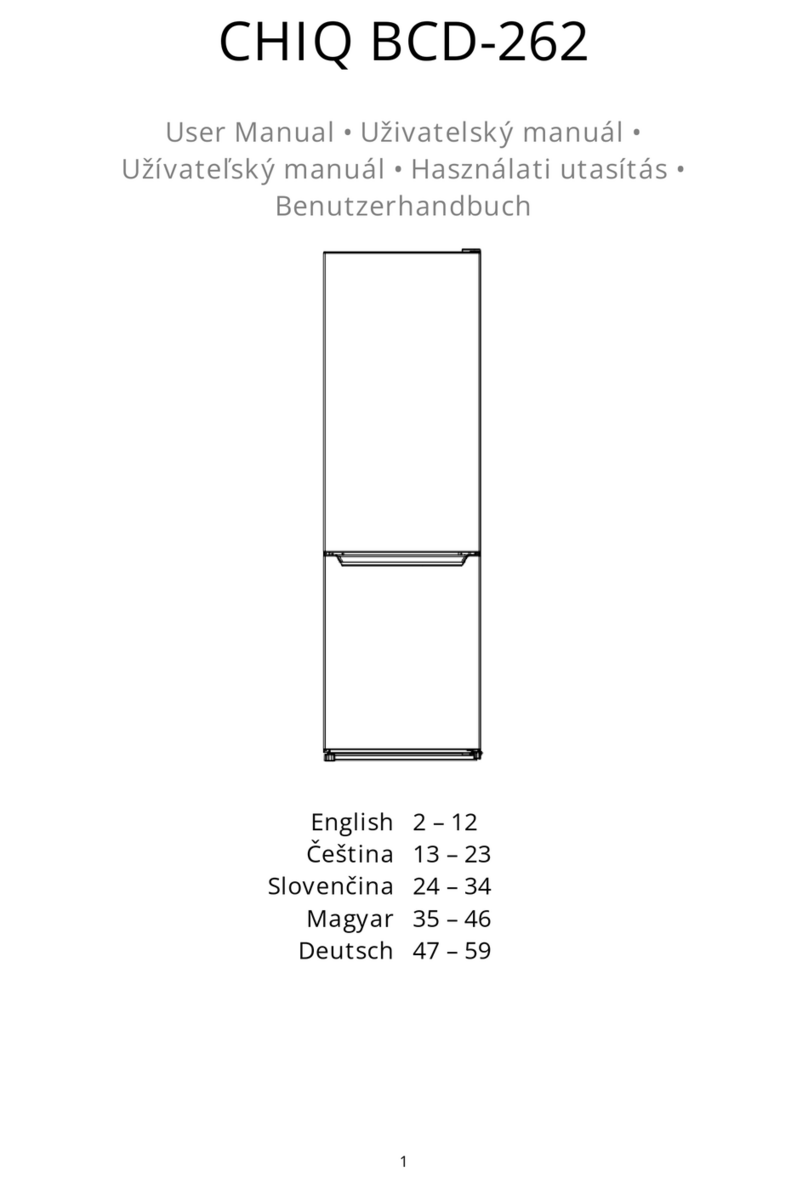
ChiQ
ChiQ BCD-262 User manual

ChiQ
ChiQ FBM250NE42 User manual

ChiQ
ChiQ MRF-262 User manual
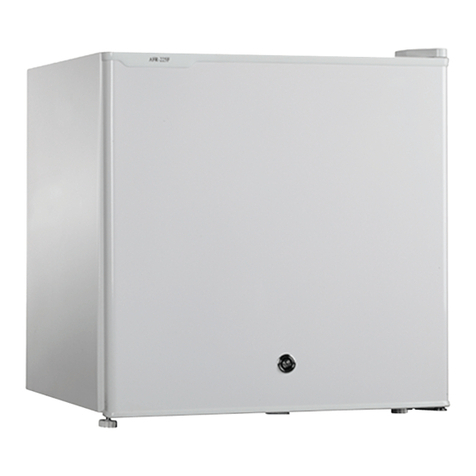
ChiQ
ChiQ CQRD01Z1GD1F User manual

ChiQ
ChiQ CRTM213B User manual
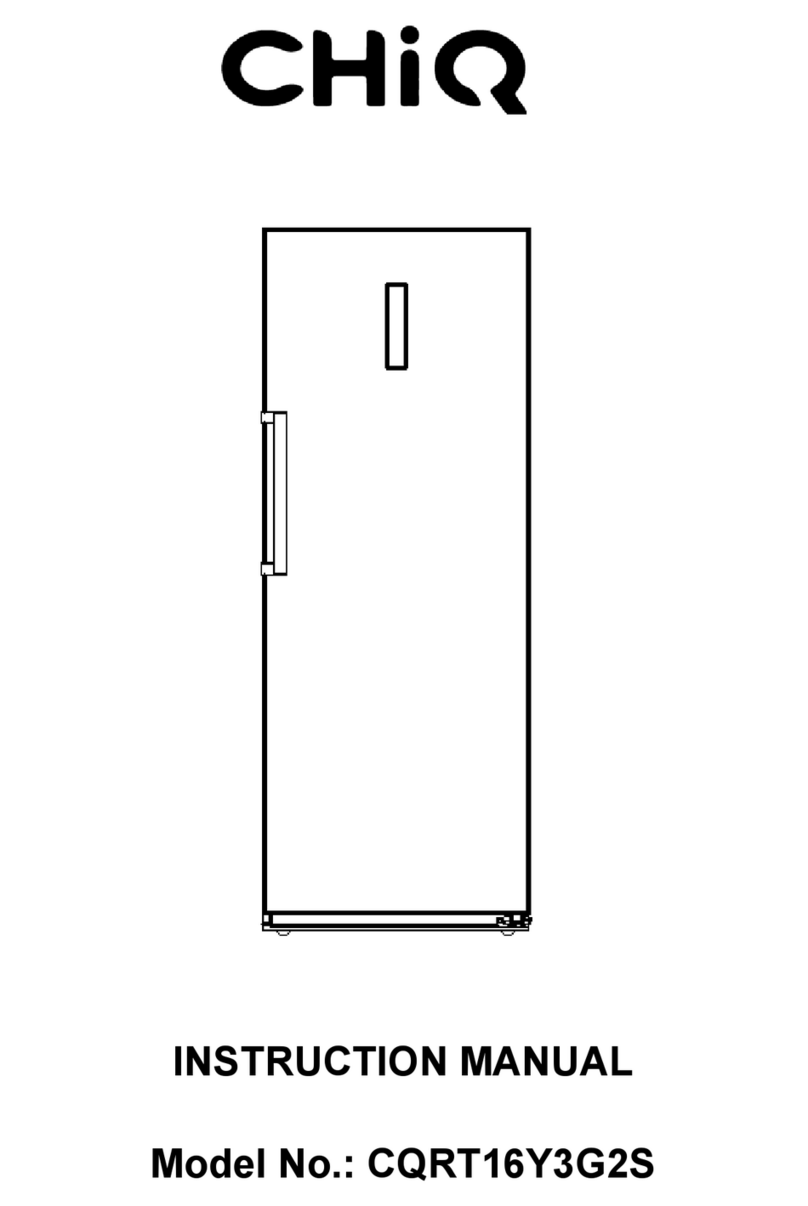
ChiQ
ChiQ CQRT16Y3G2S User manual

ChiQ
ChiQ CQRT12Y3G2RS User manual

ChiQ
ChiQ CQRQ15Y4G2RS User manual

ChiQ
ChiQ CPS570F User manual
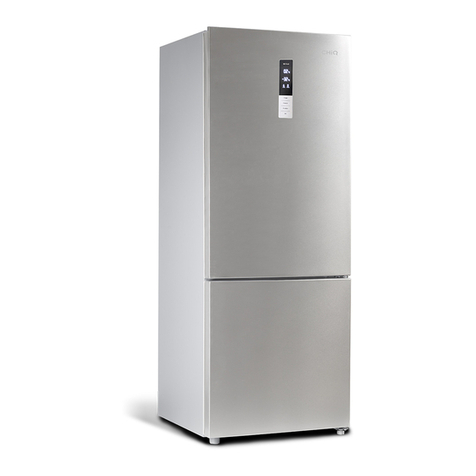
ChiQ
ChiQ CBM432W User manual
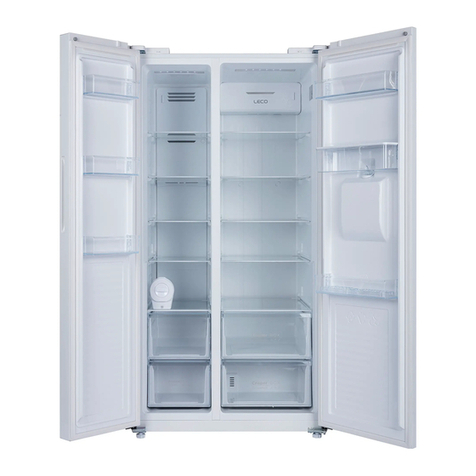
ChiQ
ChiQ MRF-630W User manual

ChiQ
ChiQ CQRQ15Y1GD1RS User manual
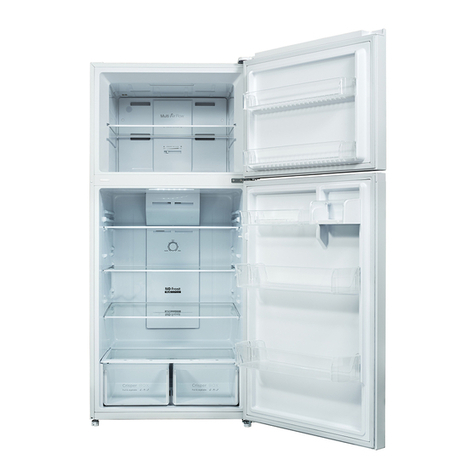
ChiQ
ChiQ CTM550W User manual

